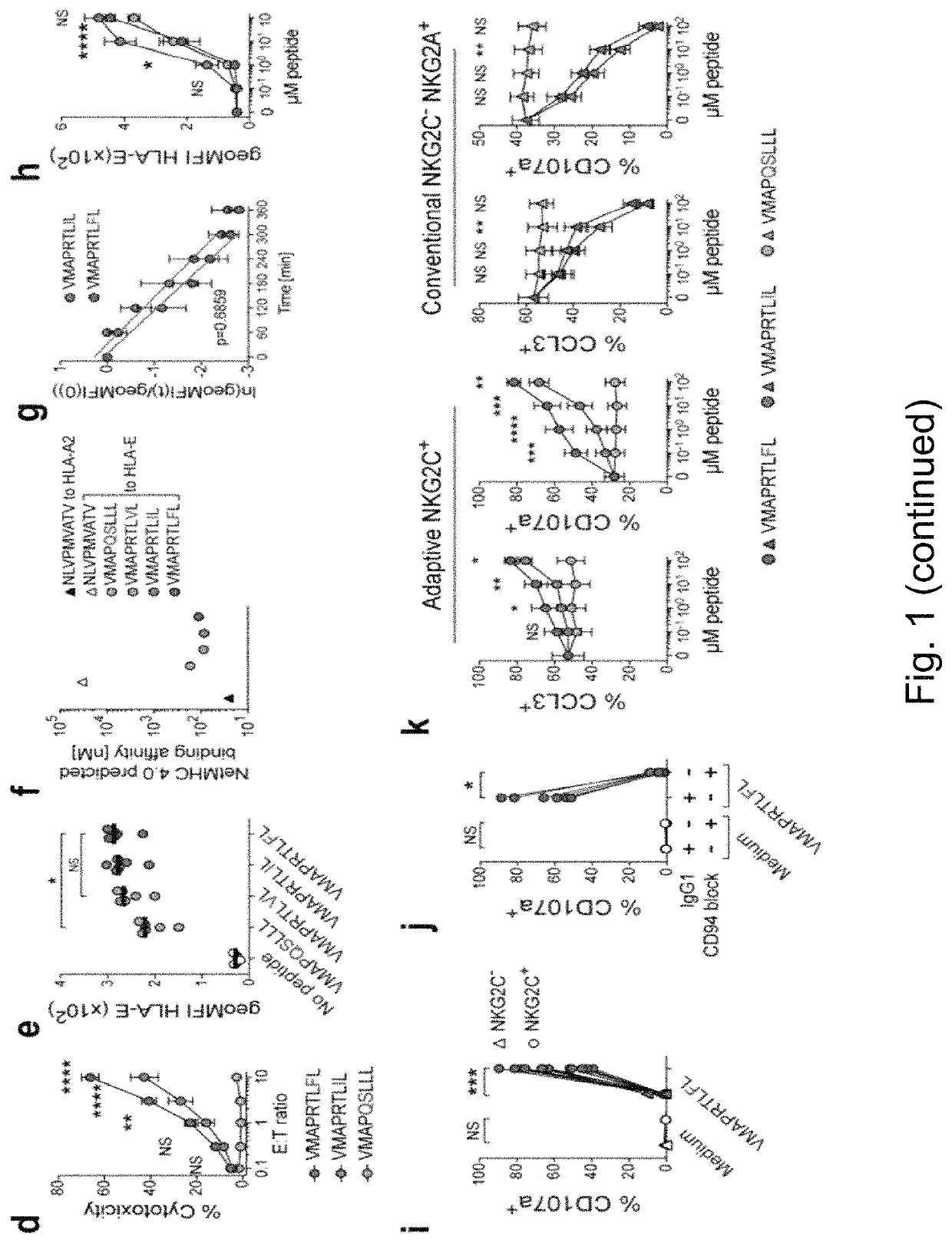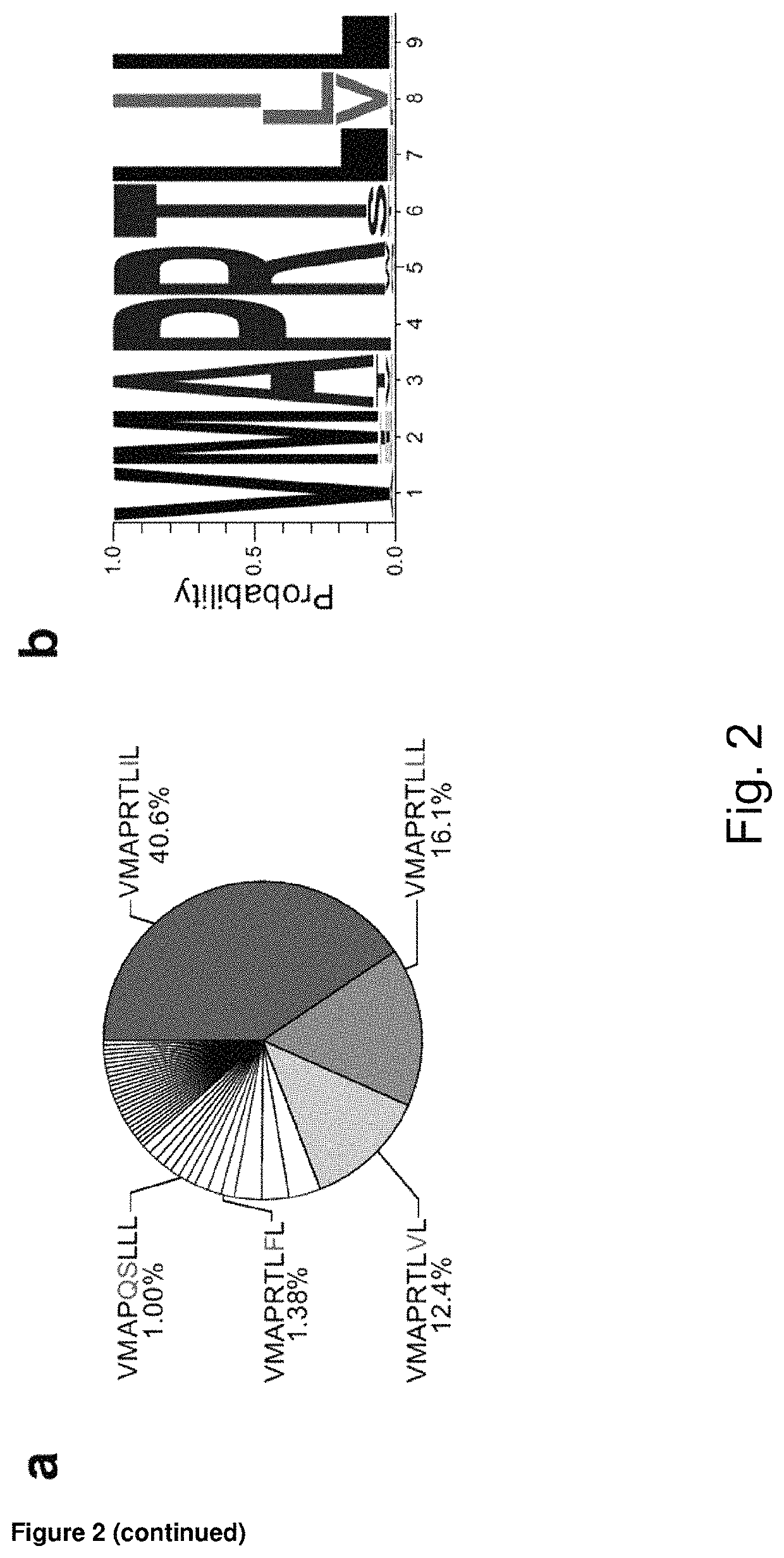Activation and expansion of NKG2C+ NK cells
a technology of nkg2c+nk cells and activation and expansion, which is applied in the field of isolated peptides to achieve the effects of preventing an effective immune response, and preventing an effector immune respons
- Summary
- Abstract
- Description
- Claims
- Application Information
AI Technical Summary
Benefits of technology
Problems solved by technology
Method used
Image
Examples
example 1
Variations in HCMV UL40-Encoded Peptides Control the Activation of Adaptive NKG2C+ NK Cells
[0213]Elevated frequency of NKG2C+ NK cells as well as an altered receptor repertoire, including preferential expression of CD2 combined with low levels of Siglec-7, NKG2A, and FcεR1γ, is a central feature of the NK-cell repertoire in healthy HCMV+ individuals (5, 6, 7, 8, 10). However, both the percentage of NKG2C+ NK cells and their CD2+ Siglec-7− NKG2A− FcεR17− adaptive phenotype are prominently heterogeneous, as indicated by the respective coefficients of variation (CV) (FIG. 1a, b). This heterogeneity suggests the involvement of variable host or HCMV factors in driving the expansion and differentiation of adaptive NKG2C+ NK cells among different individuals. In quest of virus factors driving this phenomenon, we performed an integrated analysis of 217 clinical isolates obtained by combining sequencing of viral UL40 DNA with a meta-analysis of reported HCMV isolates. The analysis corroborat...
example 2
atory Signals are Required to Elicit Polyfunctionality of Adaptive NKG2C+ NK Cells Upon Engagement with Sub-Optimal Peptides
[0214]Since NK cells generally rely on cross-linking of multiple receptors for proficient activation, we next examined whether differences in peptide recognition could be overcome by co-engagement of additional NK-cell receptors. Stimulation with peptide-pulsed K562 / HLA-E, which express a broad range of ligands for NK-cell receptors, resulted in overall amplified NKG2C+ cell activation, while the hierarchy among peptides was maintained (FIG. 3a). Since effector functions were strongly decreased by blocking the LFA-3-CD2 axis (11) (FIG. 3b, c), we next examined whether peptides recognized with low or intermediate functional avidity could preferentially benefit from CD2 co-stimulation by using RMA-S / HLA-E transfected with human LFA-3. While stimulation with VMAPRTLFL (SEQ ID NO. 2)-pulsed RMA-S / HLA-E was sufficient to induce consistent co-expression of multiple e...
example 3
NKG2C+ NK Cells Differentially Recognize HCMV-Encoded Peptides During Infection
[0215]To ascertain whether distinct UL40-encoded peptides could be differentially recognized by adaptive NKG2C+ NK cells during infection, we re-inserted the immunomodulatory US2-6 genes into the TB40 BAC4 and genetically modified the UL40 locus of the resulting repaired TB40 (TB40R) HCMV strain to encode either VMAPQSLLL (SEQ ID NO. 12), VMAPRTLIL (SEQ ID NO. 3), or VMAPRTLFL (SEQ ID NO. 2) peptides (FIG. 5a). Upon infection of primary human umbilical vein endothelial cells (HUVEC), UL40 transcripts were abundantly present as early as 16 hours post infection (FIG. 6a) and the genetically modified viruses were equally efficient in infecting HUVEC (FIG. 5b, c) as well as in modulating HLA class I levels (FIG. 6b). In line with previous reports, HCMV infection of HUVEC did not result in HLA-E up-regulation (33) (FIG. 6c). Importantly, adaptive NKG2C+ NK cells displayed significantly elevated TNF, IFN-γ, CD1...
PUM
| Property | Measurement | Unit |
|---|---|---|
| weights | aaaaa | aaaaa |
| weights | aaaaa | aaaaa |
| weights | aaaaa | aaaaa |
Abstract
Description
Claims
Application Information
 Login to View More
Login to View More - R&D
- Intellectual Property
- Life Sciences
- Materials
- Tech Scout
- Unparalleled Data Quality
- Higher Quality Content
- 60% Fewer Hallucinations
Browse by: Latest US Patents, China's latest patents, Technical Efficacy Thesaurus, Application Domain, Technology Topic, Popular Technical Reports.
© 2025 PatSnap. All rights reserved.Legal|Privacy policy|Modern Slavery Act Transparency Statement|Sitemap|About US| Contact US: help@patsnap.com



